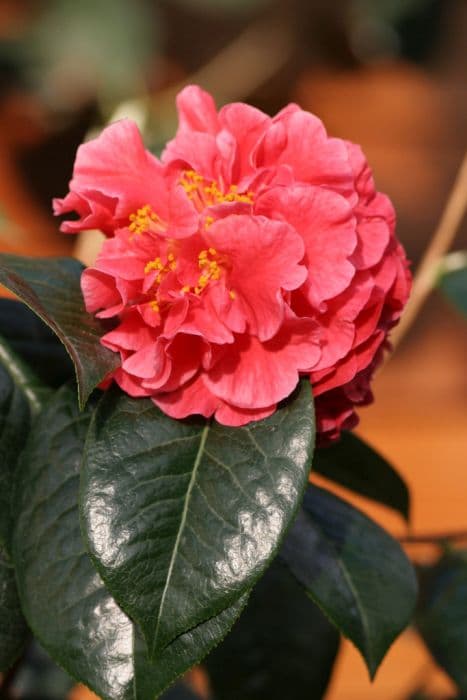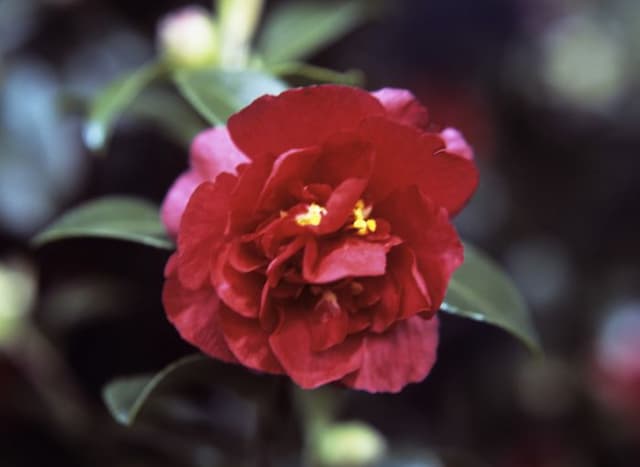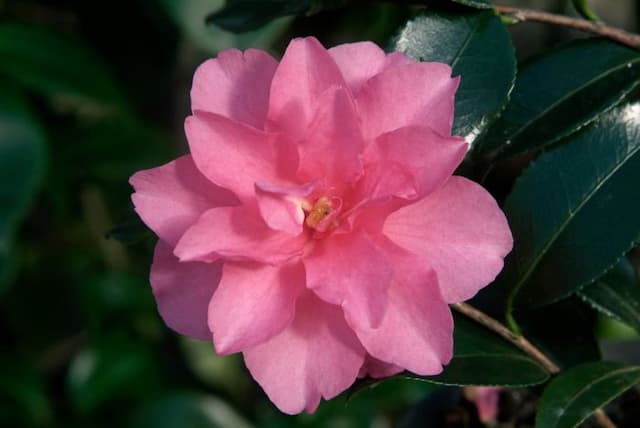Japanese camellia Camellia japonica 'Debutante'

ABOUT
The Camellia japonica 'Debutante', commonly known as the Japanese camellia, is a stunning flowering shrub known for its lush, glossy green leaves and magnificent blooming capacity. The leaves are oval-shaped with slightly serrated edges and maintain a rich, dark green color throughout the year, providing a perfect backdrop for its flowers. The 'Debutante' variety is particularly celebrated for its profuse and showy blooms. The flowers are large and peony-like in form, often compared to the ruffles of a dancer's dress. Each flower comprises numerous layers of soft pink petals that are delicately arranged in a full, rounded fashion. The blossoms exude an air of elegance and a subtle fragrance that attracts the attention of both gardeners and passersby. These flowers appear typically in the cooler months and can last for several weeks, bringing a splash of color to gardens when many other plants are dormant. The overall appearance of the Camellia japonica 'Debutante' is one of classic beauty and grace, making it a beloved choice for ornamental gardens and landscape focal points.
About this plant
 Names
NamesFamily
Theaceae.
Synonyms
Japanese Camellia, Common Camellia, Debutante Camellia.
Common names
Camellia japonica 'Debutante'.
 Toxicity
ToxicityTo humans
Camellia, more commonly known as Camellia, generally is not considered toxic to humans. It doesn't have a known history of causing serious poisoning or death when ingested. Consequently, accidental ingestion of its leaves, flowers, or other parts is not usually associated with severe or life-threatening symptoms.
To pets
Camellia is also not considered toxic to pets. It is generally safe for dogs, cats, and other domestic animals. If a pet ingests parts of the Camellia plant, it is unlikely to suffer from significant poisoning. No specific symptoms of poisoning are typically observed in pets after ingestion of Camellia plants. However, it's always advisable to monitor pets for any unusual reactions after ingesting any plant material, as individual animals might have different sensitivities.
 Characteristics
CharacteristicsLife cycle
Perennials
Foliage type
Evergreen
Color of leaves
Dark green
Flower color
Pink
Height
6-10 feet (1.8-3 meters)
Spread
5-7 feet (1.5-2.1 meters)
Plant type
Shrub
Hardiness zones
7-9
Native area
Japan
Benefits
 General Benefits
General Benefits- Aesthetic Appeal: Adds beauty to the garden with its lush, glossy leaves and large, rose-like flowers.
- Seasonal Interest: Blossoms mainly in late winter to early spring, providing color and interest during otherwise dormant months.
- Versatility: Suitable for various garden settings, including borders, foundation plantings, or as a specimen plant.
- Wildlife Attraction: Attracts pollinators like bees, which are essential for garden health and biodiversity.
- Longevity: Once established, camellias are long-lived plants that can thrive for many years with proper care.
- Shade Tolerance: Prefers partial shade, making it an ideal choice for under-canopy plantings or north-facing gardens.
- Drought Resistance: Mature plants can withstand periods of drought, though they prefer consistent moisture.
- Low Maintenance: Requires minimal pruning and care once established, saving time and effort for gardeners.
 Medical Properties
Medical PropertiesThis plant is not used for medical purposes.
 Air-purifying Qualities
Air-purifying QualitiesThis plant is not specifically known for air purifying qualities.
 Other Uses
Other Uses- Camellia japonica 'Debutante' can be used as a natural fabric dye, producing shades of pink or gray depending on the mordant used.
- The petals of the Camellia can be incorporated into potpourri blends for their color and subtle fragrance.
- Pressed Camellia flowers are often used in craft projects, like homemade paper or botanical art pieces.
- The flowers can be used to decorate dishes, especially in haute cuisine, as an edible garnish that is safe if consumed.
- Camellia wood, being hard and durable, can be carved into small objects like buttons or jewelry.
- Camellia blossoms are sometimes used in traditional ceremonies, for example in weddings as part of a bridal bouquet or decoration.
- The petals can be used to make natural confetti, which is biodegradable and environmentally friendly.
- Flower essences made from Camellias are used in aromatherapy for their purported emotional healing properties.
- Leaves from the Camellia plant can be used to create a natural green pigment for artist paints or inks.
- When dried, the branches of Camellia japonica can be used in decorative floral arrangements that require a sturdy structure.
Interesting Facts
 Feng Shui
Feng ShuiCamellia is associated with positive energies in Feng Shui, often symbolizing love, affection, and admiration. It can be used in the southwest sector of a garden or home to enhance the energy of love and relationships, or in personal 'love corners' to invite romance and partnership. However, its exact variety, 'Debutante', does not change its basic Feng Shui use.
 Zodiac Sign Compitability
Zodiac Sign CompitabilityCamellia is not used in astrology practice.
 Plant Symbolism
Plant Symbolism- Adoration - Camellias, often gifted to express admiration, can represent deep affection or adoration towards someone.
- Perfection - With its flawless and intricate petals, the 'Debutante' camellia is associated with the ideal of perfection.
- Longevity & Faithfulness - As an evergreen with a long blooming season, the Camellia symbolizes enduring commitment and fidelity in relationships.
- Love - In general, camellias signify love, and 'Debutante', with its beautiful, soft pink flowers, might be particularly representative of a gentle, devoted love.
- Refinement - The lush petals and overall aesthetic of the Camellia suggest sophistication and the finer things in life, signaling a sense of refinement.
 Water
WaterThe Camellia japonica 'Debutante', commonly known as the Debutante Camellia, needs to be watered thoroughly to maintain moist soil, especially during dry spells. Water the Debutante Camellia with deep soakings, using about 1 to 1.5 gallons of water per week during the growing season, adjusting for rainfall. Reduce watering in the fall and winter when the plant is not actively growing. It’s important to avoid overwatering which can lead to root rot, so ensure that the plant has well-draining soil and never let it sit in waterlogged conditions.
 Light
LightThe Debutante Camellia thrives in partial shade, though it can tolerate morning sun with afternoon shade. Place it in a spot that avoids the intense heat of the midday sun, which can scorch its leaves. Dappled sunlight under a canopy of tall trees is ideal for these shrubs, mimicking their natural forest understory habitat.
 Temperature
TemperatureThe ideal temperature range for the Debutante Camellia is between 60 and 80 degrees Fahrenheit. Camellias can tolerate temperatures down to about 20 degrees Fahrenheit, but they should be protected from frost to prevent damage to flowers and buds. They perform best in conditions where they are not exposed to extreme temperature fluctuations.
 Pruning
PruningPrune the Debutante Camellia immediately after flowering finishes, typically in the spring, to maintain shape and promote bushier growth. Remove any dead or weak branches, as well as branches that cross or rub against each other to encourage airflow. Light pruning can be done to shape the plant or reduce size, but heavy pruning should be avoided as it can reduce flowering.
 Cleaning
CleaningAs needed
 Soil
SoilThe best soil mix for the Camellia, commonly called Japanese Camellia, is acidic, well-draining, and rich in organic matter. The ideal pH for the soil should be between 5.5 to 6.5. A mix containing equal parts of peat moss, pine bark, and perlite would provide the necessary conditions for healthy growth.
 Repotting
RepottingJapanese Camellias should be repotted every 2-4 years. They prefer to be root-bound to some extent, so frequent repotting is unnecessary. Choose a slightly larger container each time to facilitate continued growth.
 Humidity & Misting
Humidity & MistingJapanese Camellias thrive in moderate to high humidity levels, ideally between 40% to 60%. They benefit from being placed in a naturally humid environment or from humidity trays and regular misting if the ambient humidity is too low.
 Suitable locations
Suitable locationsIndoor
Use a bright spot, shield from direct sunlight, and keep evenly moist.
Outdoor
Part shade, protect from strong winds, ensure acidic soil, mulch well.
Hardiness zone
7-9 USDA
 Life cycle
Life cycleCamellia japonica 'Debutante', commonly known as the 'Debutante Camellia', begins its life as a seed, germinating in a moist, well-drained environment. The seedling grows to form a young shrub with glossy, evergreen leaves, entering a vegetative stage where energy is primarily invested in growth and leaf production. As the plant matures, it enters a reproductive stage, usually within a few years, developing buds that bloom into large, pink, peony-like flowers between winter and early spring. After pollination, usually by bees, the flowers fade and form seed pods, which mature and release seeds to start the next generation. In ideal conditions, Debutante Camellia can live for many years, becoming an established shrub that goes through yearly cycles of growth, flowering, and seed production. Throughout its life, the plant requires maintenance, such as regular watering, fertilization, and pruning to keep it healthy and promote vigorous flowering.
 Propogation
PropogationPropogation time
Spring-Early Summer
Camellia japonica 'Debutante', commonly known as the Debutante Camellia, is typically propagated by semi-hardwood cuttings taken in late summer to early fall, after the blooms have faded and new growth has begun to harden. This method involves selecting healthy, disease-free cuttings about 4 to 6 inches (10 to 15 centimeters) long with several leaves. The lower leaves are removed, and the cut end is dipped in a rooting hormone to encourage root development. The cuttings are then inserted into a pot filled with a well-draining potting mix, ensuring that at least two nodes are below the soil surface. The pot is kept in a humid, bright environment, out of direct sunlight, and maintained to ensure the soil remains moist but not waterlogged. Roots typically develop within a few months, after which the new plants can be transplanted into individual pots or directly into the garden.









